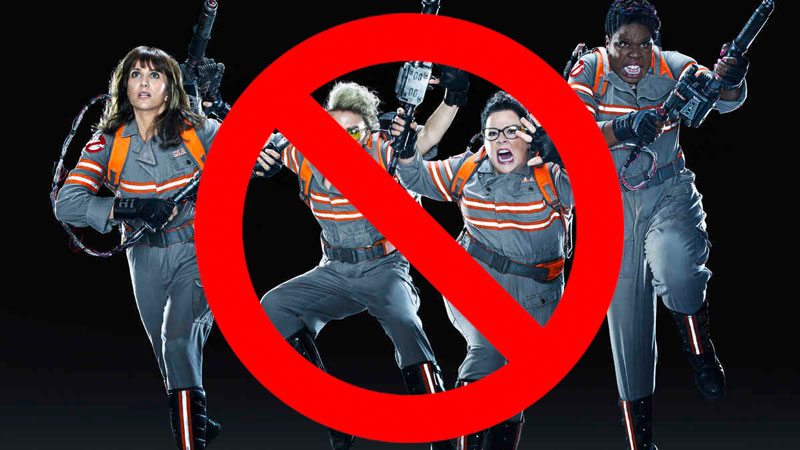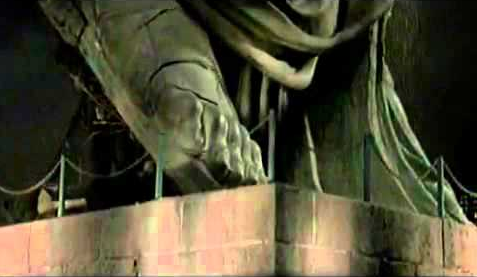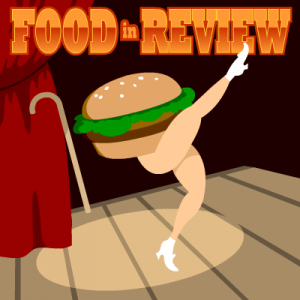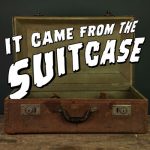I went to see the 2016 Ghostbusters, and I hated it. I hated more than I usually hate hateful movies, and I haven’t been able to shake that hatred for days. Seeing other people online talk about how funny and good the movie was just stoked my hatred even more, so I had to write this all down to get it off my chest. I wrote a 4000-word diatribe on how bad the new Ghostbusters movie is, and how stupid and bad you are for liking it, and then Word crashed and I lost all my work. But I am so filled with disgust that I sat down and wrote the goddamned thing all over again. And here it is.
Too Much Money at Half the Price
I wasn’t going to see 2016 Ghostbusters. When those first few trailers hit, I could tell it was going to be bad. The fact that one character quipped such an uninspired, stock phrase as “that’s gonna leave a mark,” and that the filmmakers thought the moment was funny enough to include in the trailer, made it clear that this was not a choice pick for the ol’ Ryry.
(here’s the same line delivered by another fat comic, over 20 years ago, when it MIGHT have been funny. But probably not.)
My friend invited me to see it on opening night, and he said he had a two-for-one coupon. So maaaybe I’d watch it at half the price, if only to be included in the conversation, whether the movie was good or bad. Once i had agreed to come, the friend announced that he had purchased $17 IMAX tickets, which was not welcome news. But still, $8.50 with the two-for-one coupon is a relatively cheap night at the movies these days. THEN when I met up with him, the friend sheepishly admitted that he hadn’t read the fine print on the coupon, and that it wasn’t valid on Fridays. So there I was, spending a full seventeen dollars on a movie I suspected was going to be terrible.
But since I like to get my money’s worth, and because I enjoy the company of the guys in the group, I decided to try to eke seventeen dollars of entertainment out of the experience.
It was like wringing blood from a stone.
Trigger Warning: Terrible Filmmaking
I’m going to be talking about this movie as if you’ve either already seen it, or as if you don’t care to (which is a very valid and laudable position to take, so good on you). So, spoiler alert. As in, “this movie spoils everything you hold dear.”
It’s not at all true that a bad remake doesn’t affect your enjoyment of the original. I saw Ghostbusters 2 in the theatre when it premiered, and it was so disappointing that it taints every successive viewing of the original movie for me. I can’t watch Ghostbusters without being reminded of that stupid talking Viggo painting, or the annoying curly-haired curator, or the end-credits rap, or the Statue of Liberty tromping around New York (how are we seeing her ankles if she’s just a statue?? Either the sculptors gave her ankles, or they didn’t. When the slime animates her, she isn’t going to magically acquire ankles that were never there to begin with when her dress moves up and down as she walks.)
Now whenever I watch the original 1984 Ghostbusters, I’m going to be reminded of… whatever the Hell this thing was.
In order to spare you any confusion, and to avoid typing 1984 or 2016 Ghostbusters, I will henceforth refer to the 2016 reboot/remake as “Goastbastards.”
Sexism
Let’s get the elephant in the room out of the way: because of how things shook out with people vehemently reacting to the news of the non-Ghostbusters 3 reboot and the sex swap, the suggestion is out there that any man who criticizes this film is doing so because he is sexist. But as my friends and I agreed after the movie, you could have put men in these roles, and the flick would have been just as bad. The writing and direction were so weak that it didn’t matter whether the Goastbastards fired their proton packs standing up or sitting down.
I’ve also heard reviewers claiming that the film is filled with “man-bashing.” I don’t think that’s strictly true, although there were a few eye-rolling “girls can do it too!” moments that I’ll try to detail here:
- Wiig’s dean/department head boss at Columbia suggests she dress in something other than her ridiculous and prudish powersuits. He doesn’t specify what she should wear, so it’s not like he’s a creepy man-boss asking for more boob cleft or anything, but this may have been a very subtle scene about workplace harassment.
- All the men in the movie are either stupid or mean. This might be a criticism of flicks like Sin City, where all the women in the movie are either hookers, strippers, or assassins, but I doubt it. I think it was just an attempt to stock the pond with funny comic relief characters (emphasis on “stock”), but none of them were funny (“What about Kevin?” you ask, because you wouldn’t know a joke unless it pied you in your stupid non-joke-knowing face. No, not even Kevin)
- At some point halfway through the movie, I thought “some bad guy’s gonna get it in the nuts.” Sure enough, he does… in the first unironic getting-it-in-the-nuts moment I’ve seen since maaaaybe Monster Squad in the 80’s, or some off-brand 3D kids’ movie by not-Pixar. There’s a reason we don’t do getting-it-in-the-nuts moments in movies any more: they’re played out and unfunny. But I guess there was a Higher Purpose to this one, because Women.
- The Goastbastards’ receptionist (we don’t say “secretary” any more) is a MAN. And he’s a GOOD-LOOKING man named Kevin, and he’s monumentally stupid. Kevin is so stupid he doesn’t know what a phone is. That’s pretty stupid, right guys? And Wiig’s supposedly brilliant physicist character, who ought to have higher standards, lusts after him the entire movie, unfunnily. (Our takeaway, I guess, is that sexual harassment in the workplace is okay if women do it. Or that we’re turning everything on its heels, MAN. Cats and dogs living together. Mass hysteria. I dunno.)
- Kevin is roundly objectified. During the closing credits, topless shots of him in firefighter calendar poses float across the screen. This had the effect, for me, of people claiming that “cracker” is the equal and opposite epithet for “nigger.” It’s not – not historically, not viscerally. The suggestion that a few shots of Chris Hemsworth with his shirt off are an effective attempt at balancing Hollywood’s sexism equilibrium is way off the mark.
- The women read an unkind comment on their YouTube video, in a nod to the kind of vitriol the filmmakers faced in the run-up to Goastbastards.
- The movie abounds with much misplaced and obnoxious girl power woo-hooing, which reads on the surface as “woo hoo I’m a Ghostbuster,” but really comes off as “woo hoo I got a part in a summer blockbuster.” Whatever the motive, it’s frequent and grating.
- There’s a queef joke.
If Goastbastards is pointing its accusatory cannon anywhere, it can’t be at the original Ghostbusters, which was filled with admirable and enviable roles for women. Just the presence of Alien ass-kicker Sigourney Weaver tells you you’re not getting a shrinking violet; her Dana is a successful professional with an expensive Manhattan apartment who is dating a similarly successful (if coke-addled) musician. She only turns to the crackpot Ghostbusters out of desperation. Annie Potts is just sleepily collecting a paycheque, and doesn’t buy into the boys’ vision statement until they start earning money (“We GOT ONE!!!!!”) The Civil War ghost gives Aykroyd a beej, sure, but that was mostly cut from the movie. The airhead student off the top of the film doesn’t clue in that Venkman is cheating her psychic card-guessing results in order to pick her up, but the film’s Big Boss takes the form of a woman and very nearly kicks their asses, so I think the film is heavily weighted in favour of strong ladies.
Racism
Another criticism I see often enough is that Goastbastards is racist, because Leslie Jones, the black Goastbastard, does Sassy Black Lady things as the film’s resident Sassy Black Lady (“Aw HELL naw!”) Today’s audiences are probably too uninformed and uneducated to know that having a black character tiptoeing down a hallway, teeth chattering and worrying about “spooks” (which is exactly what we get here) is inherently racist, just as any movie would be if it upheld other, lesser-known stereotypes about black people (i.e. “black people can’t swim”). Ernie Hudson was used much more sparingly in Ghostbusters. We didn’t see him bumbling down a hallway saying “Lawdy lawd … what is I gonna do about dese here g-g-goasts?”
Anyway, these aren’t really my preferred bones to pick. There are ample problems to point out without bringing any isms into it, except of course for scathing criticism.
The Special (As in “Special Ed”) Effects
I’ve given up the hope of being impressed by special effects ever since we transitioned to All Phony CG All the Time, but when I heard Goastbastards employed considerable practical effects, my hope was rekindled. Alas, it was for nought.
At one point in Goastbastards, the villain says something like “Welcome to the Times Square of the past!” I thought “Hmm… that’s kind of a neat idea.” But all I saw was a blue smudge, instead of a transformed battle arena fringed with vaudeville theatres. Once, out of the corner of my eye, I saw a Lon Chaney movie poster. There were glowing blue ghosts who were… what, exactly? I couldn’t tell. I saw one in a tricorn hat that I think might have belonged to a pilgrim ghost. I saw another wielding hatchets a la Bill the Butcher from Gangs of New York. The whole scene was presided over by a tall… ringmaster ghost thing. That was the only clear view of anything in this scene. The rest was an azure blur of indistinct day-glo ghosts.
I haven’t seen Melissa McCarthy in any movies, except for (mercifully) one cameo. I gather that because she’s overweight, the fun thing to do with her is to rig her up to a harness and fly her around the set while she yells some stock unfunny phrase (here, it’s “I feel like I’m wrestling a gator!” as she struggles with her proton pack). They fly her numerous times in the movie, and each time I could see two pinched points on her coveralls where the harness gripped her, and her movements around the set were so unnatural that I could almost picture the rig, even though it was painted out.
The climax has Wiig’s character making the Ultimate Sacrifice to save her friend (to preserve a relationship that we the audience care very little about, and it’s consequently hard to believe Wiig’s character cares about it either), by jumping into a swirling ghost vortex. The camera tracking on the actors vs. the vortex effects are so phony and out of whack that they manage to recall the original Superman movie’s blue screen effects from decades earlier.
The Rules
Any fantasy world has to define its rules for it to be enjoyable. It wouldn’t be fun if Harry Potter started busting out all these high-level spells that he’d neither learned nor practiced, in a world where spellcasting has to be studied in school for many years. (Some movies, like The Dark Crystal, E.T., and Pacific Rim, pull out an “I have this superpower now” moment to good effect.) Goastbastard breaks a lot of rules of the universe, and redefines rules in bizarre ways that don’t make sense and aren’t fun.
The proton weapons were never meant to eradicate ghosts. They were like electric lassos that corralled ghosts into vacuum-like traps, and once captured, the ghosts had to be stored in a containment unit. In Goastbastards, the heroes’ weapons actually murder goasts (??). There’s a James Bond scene with Holtzmann standing in for Q where she runs down all of the experimental weapons she’s built (with no time and no money), all of which work perfectly in the heat of battle (with no ghosts to test them on), including a ghost-smashing gauntlet and a ghost wood chipper. These weapons make the ghosts… die, I guess? At the end of the Times Square battle, the Goastbastards can be seen stepping over the corpses of dispatched spectres. Ghost corpses. What the how?
One of the rules in Ghostbusters is that There Are Ghosts. The ghosts appear after significant spectral build-up, like an orgasm from the Great Beyond. (Aykroyd is dick-obsessed, if you haven’t noticed… see also his penis-nosed judge character in Nothing But Trouble, and the obvious parallels between ectoplasm and semen.) Goastbastards rewrites this rule to read “There Are Not Ghosts,” and cooks up an unnecessary villain to make there be ghosts.
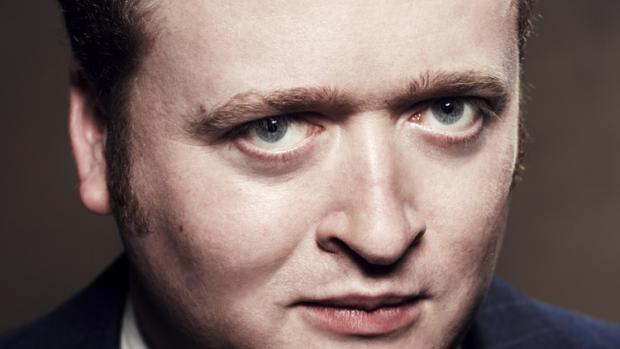
Neil Casey’s performance was probably the most subtle of the lot, and he still comes off like he’s in a Disney Channel movie.
I’m not sure why there are mostly humanoid ghosts in the movie, but every so often there are non-humanoid ghosts like Slimer and the dragon demon theatre ghost. Is he from a dimension where there are dragon demon theatre ghosts? No idea. I think I remember The Real Ghostbusters having winged, non-human dragon ghosts? Maybe this is an attempt to reconcile the cartoon and the movies? I just don’t know. And why is the humanoid Times Square ringmaster ghost 30 feet tall? Was he 30 feet tall when he was alive? No? Then why now? The filmmakers were probably just thinking “some ghosts are big, because that’s neat,” and that’s all the world-building thought and effort they put into it.
The weapons in Ghostbusters were dangerous. Numerous lines refer to them being hot to the touch, and they set things on fire. In Goastbastards, the weapons are only radioactively “hot,” and they pose no threat to humans – only to property. The women explode all kinds of things in the alley outside their office, but no one ever gets hurt, or is in danger of getting hurt. That’s because these are cartoon characters, not real people. Melissa McCarthy gets wire-lifted six feet off the ground trying out her proton pack (while unfunnily quipping “it’s like I’m wrestling a gator” because the writers are stupid and lazy and should never work again), but she lands on the pavement without injury. Yet in another scene, we’re supposed to fear for a character who is dangled from a not-very-high second storey window. The tension is already broken. Nobody gets hurt, so the audience can’t care.
During the climax, the villain uses his goast powers to freeze hundreds of people in Times Square into a Michael Jackson pose. You know who he doesn’t freeze into a Michael Jackson pose? The only four people in the area who are carrying goast-busting weapons.
(The Michael Jackson poses are meant to kick off a dance sequence that never happens. It’s obvious that test audiences recommended it be nixed, likely because it was supremely dumb. The whole dance is transplanted without comment into the closing credits, and yes, it’s supremely dumb.)
Unlike in Ghostbusters, there is no Cardinal Rule (like “don’t cross the streams”) that must be followed lest the heroes cause the end of the world, a rule which they then break (tension! conflict!) in order to defeat the Big Boss. There is no rule to the proton weapons, except that they work perfectly all the time when used on ghosts, in unpracticed hands.
Once the Goastbastards start catching goasts in earnest, they are instantly believed, because they do it in front of thousands of people at a heavy metal concert. It was more fun in the original Ghostbusters, when it was very plausible throughout the whole movie that the Ghostbusters were just hucksters. (In fact, that’s the whole premise that Ghostbusters 2 is predicated on.)
Looking Back
Goastbastards throws away a lot of what made its progenitor great, and keeps (or makes reference to) many of the things that no one cares about, including a bunch of painfully bad cameos. Here are some of the references:
- There’s a bust of Harold Ramis in a hallway. We’re supposed to go “look, it’s Harold Ramis.” And…? I’m not sure what else.
- The Victorian mansion ghost is an obvious nod to the library ghost from Ghostbusters.
- Slimer and his wife/girlfriend show up. (He doesn’t look like a person, but she has a beehive hairdo like a person, because who the Hell knows.) Later, the two ghosts feature in a weird possible reference to Die Hard 2.
- One character says “Who you gonna call?” A television responds “Ghost Jumpers!” The Ghost Jumpers (an A&E style reality show) is never mentioned again, and exists only for that joke.
- Dan Aykroyd shows up and says “I ain’t afraid of no ghosts.” Get it? Because that was a line in the song. GET IT??
- The women unnecessarily question a graffiti artist in the subway, asking him if he’s seen an electric chair ghost. He says “yeah, I’ve seen a ghost,” and proceeds to draw a ghost on the wall that looks nothing like the electric chair ghost, but everything like the Ghostbusters logo, complete with the red no-smoking symbol around the black-outlined ghost, even though he’s only holding one can of spray paint. This scene serves to justify the origin of the Ghostbusters logo, because everyone was dying to know. The women then carry on towards the subway tunnel, where they knew they could find the electric chair ghost the entire time on their own without needing to question anyone about anything.
- Bill Murray puts in an unfunny cameo and is quickly, mercifully dispatched out a window.
- Annie Potts shows up with the best cameo in the movie (which isn’t saying much), seemingly reprising her role as Jeanine. She’s actually reasonably funny, not because of anything she specifically says, but because of her characterization (are you taking notes, Kate McKinnon as Holtzmann?)
- Ernie Hudson makes a cameo as Tolan’s uncle. He gets the last line of the movie, and it isn’t funny, but it’s tolerable, because he acts like a real human being instead of a comic book character.
- Sigourney Weaver appears in an end credits scene as Holtzmann’s mentor, playing a more subdued version of the character, making me wish Weaver had played Holtzmann the entire time… or at least had coached Kate McKinnon on how to play quirky without grossly overacting. Weaver shares an awkward high five with McKinnon and says “I don’t like doing that,” which marks her Unfunny Joke contribution to the film.
- Wiig pounds on the glass window at a fancy restaurant like Rick Moranis does in Ghosbusters.
- The Goastbastards visit an old music hall that is hosting an Ozzy Osborne concert in the middle of the day for some reason. The snooty music hall manager evokes the snooty hotel manager from Ghostbusters, except that the snooty hotel manager makes a lot more sense in a snooty hotel with snooty clientele and expensive furnishings all around. It doesn’t make sense for the snooty music hall manager to call out “be careful – those are original art deco moldings!” as the Goastbastards fire up their proton packs, when the theatre is hosting a goddamned Ozzy Osborne concert and the hall is packed with thousands of thrashing heavy metal fans. Ozzy shows up, by the way, and – typical of the cameos in this film – says something unfunny before the camera resignedly cuts away.
- In one of the movie’s few original and inspired moments, the Goastbastards are attacked by some spectral Macy’s Thanksgiving Day Parade balloons. Just as I was thinking “hey – neat idea,” the moment pops and all the goodwill rushes out in a hiss, when the women are crushed by a Stay Puft Marshmallow Man balloon. We cut to a pavement POV shot with the women’s faces pressed against a sheet of glass that doubles as the road. What they say is unfunny, but the humour is supposed to come from their faces looking squished. Remember? Remember when you were six years old and that was funny?
- In the end credits scene, one Goastbastard is listening to some ghost audio, and she asks “who is Zuul?” “That’s the name of the ghost from the first movie” my friend flatly responds in the Most Unimpressed Voice Ever. As audience members, I think we were supposed to get all tingly because the line sets up a familiar villain for the sequel. The scene offered a chance to call back to an unfunny earlier gag with a reel-to-reel recorded fart, but the writers squandered even that low-hanging comedic fruit.
- In the climax, the villain asks the Goastbastards what form he should take, as in the first film. While Stanz’s Stay Puft speech in Ghostbusters is memorable, quotable, and funny, Tolan’s is dumb. “Just do something cute,” she says. So the villain turns into a cel-animated version of the Ghostbusters logo. It steps out of the no-smoking ring (which turns into a bowtie…?), and then becomes a gigantic 3D-animated flour sack ghost with bad teeth, all of which makes no sense. (During this sequence, an unconscious Kevin says “I like ice cream,” and that – THAT is the moment that my mood shifted from disappointment to incredulous anger). This logo creature is the one that gets it in the nuts, which also makes no sense. The Big Bad has no eyelashes, no fingerprints, no toenails, and presumably no internal organs, and yet we’re supposed to believe that the villain manifested it with a fully functional set of vulnerable male genitalia? It just… I just give up.
The Real Ghostbusters
What I really loved about Ghostbusters (and the excellent David Crane video game adaptation), and what I really wanted to see explored in the reboot, was the entrepreneurial angle. In the original, the boys are fired from their jobs. Venkman and Stanz share a flask, and talk about their future with a mixture of fear, hope, and uncertainty (“Call it fate… call it karma…”). One Ghostbuster takes out a third mortgage on his house to finance the venture. There is this constant money and time pressure. The line “this magnificent feast represents the last of the petty cash” is so memorable and quotable because many of us have been there: strapped for cash and worrying about the decision to spend money on Chinese take-out instead of cooking inexpensively.

This image encapsulates my own entrepreneurial adventures, except that i could never afford that amazing fire hall. Or that Chinese food.
There’s a real excitement, then, when the boys finally get their first call. In the eventual montage, we see them on a roll as business picks up and the newspaper headlines trickle in. We see their office, their equipment, and their car improving as they can afford to make the upgrades. In a weird way, I think Ghostbusters served in some small degree to inspire my own entrepreneurial adventures.
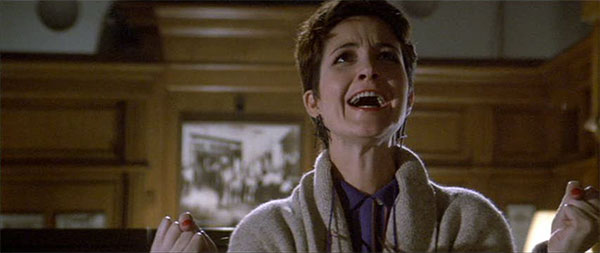
Behold: the face of a minimum wage employee who has just learned she may still have a job next week.
In Goastbastards, there’s no money pressure whatsoever. Anything the ladies want, they get. They can’t afford the fire hall (btw, take it from someone who has signed commercial leases: $20k a month in downtown Manhattan for that building is an absolute steal), so they get a stylish, spacious office above a Chinese food restaurant. (Compare and contrast the shithole state of the fire hall in Ghostbusters.)
Holtzmann is constantly building new equipment for the team, even though we never see them buying any supplies. They borrow a car from Tolan’s uncle, and Holtzmann peels around the corner out of nowhere with a new paint job, a professionally-applied logo, a siren, and a roof-mounted nuclear reactor. (Even in the mid-80’s we all knew you couldn’t get your hands on plutonium without stealing it from a minibus full of Libyans). A paint job on a car costs about $5000. Who’s realistically going to spend $5000 on a borrowed car?
There is no montage of their business growing. At the end of the hilariously destructive hotel call in which the boys have no idea what they’re doing, the Ghostbusters charge the snooty manager an exorbitant stack of 1984-bucks. Conversely, we don’t see anyone paying the Goastbastards. It’s like their business is pure research, with no hope for or plan of monetization. Where are they supposed to get money for things? How are they supposed to keep the lights on?
Holtzmann’s weaponry all works perfectly when the time comes. At one point she’s asked “will this work?” and she answers affirmatively, despite not having any ghosts to practice on. That’s not bullshit fantasy movie science. That’s just plain bullshit.
And there’s the key difference between Ghostbusters and its remake (aside from the fact that Ghostbusters is funny): the characters in Ghostbusters are real. They are real people with real problems, who react realistically. The New York City in Ghostbusters is a real place filled with real people, and they do what real people would do when faced with the unreality of ghosts. When the library spook freaks out in Ghostbusters, the boys run like Hell, because that’s what real people would do. When the mansion ghost freaks out on Kristen Wiig’s Gilbert in Goastbastards, her character just stands there, placidly rooted to the spot, while the thing screams horrifically and pukes ectoplasm on her. That’s not a genuine, believable reaction. That’s not how a real person would comport herself. Because the people in Goastbastards aren’t real people. They’re cartoon characters.
Back Off Man – I’m an Overactor
At the very beginning of the movie, there were three funny lines about a Victorian mansion, about the owner’s Irish-proof fence, and the smoking room where PT Barnum first learned to enslave elephants. Funny, but those lines were canaries-in-the-coal mine warning me that something was off. The New York of Ghostbusters was a real place. This clearly wasn’t. The mansion tour guide wasn’t making these cracks sardonically or winkingly – he was saying them as if they were true, inside the context of the movie’s universe. The universe of Goastbastards is one where ridiculous, cartoonish things happen all the time, as opposed to the “real” New York of Ghostbusters where unbelievable things happen to believable people.
As I mentioned earlier, you could swap in any cast members, male or female, and the movie would be terrible because the writing is terrible. If i need a fat brash woman for my movie, give me Rebel Wilson over Melissa McCarthy any day. But Rebel Wilson would be just as embarrassing in the role, because the lines are so bad. One of Melissa McCarthy’s lines, shouted at the villain, is “Rowan, get back here you big bully!” In another scene, she asks whether she and her compatriot should give another character a wedgie. Later, after being slapped across the face, she quips “that’s gonna leave a mark.” The lines “too much information” and “talk to the hand” are missing from the script, but they did manage to work in “aw HELL naw” for their black character.
The justification for Tolan leaving her full-time job and joining the Goastbastards is unclear. When we meet her, she conspicuously rattles off some detailed historical information about Manhattan. She uses this as justification for the group hiring her (with what money? The Ghostbusters didn’t hire Winston Zedemore until they’d built up a war chest), saying that although she wasn’t a scientist, she knew New York. Once she’s hired (accepted?) into the group, she never trolls out a single historical New York factoid again, despite ample opportunity, like busting a ghost in an art deco music hall, or being transported to a time-warp Times Square. When the ladies track ghost sightings on a map of Manhattan, Tolan’s not the one holding the pencil. The writers just throw out everything that makes her a valuable member of the team.
Likewise, idiot receptionist Kevin’s motivation to become a Goastbastard comes out of nowhere. The Ecto-2 motorbike (repainted and slickly outfitted with the “company’s” plagiarized logo thanks to all their phantom money) materializes from the ether, and Kevin complains (out of left field) that they won’t let him be a Goastbastard. (He’s never mentioned it until this point in the movie.) The scene is there because the writers need a getaway vehicle for their bad guy, even though the villain can possess inanimate objects like cars and motorbikes and, as we’re about to find out, intellectual property.
My Brain’s Containment Unit
It’s been a long time since I watched a movie that made me want to draft my own screenplay and say “here’s how you write a motherfucking comedy, you know-nothing hacks.” Goastbastards reminded me, painfully, that comedy movies are very dumb these days, because audiences are very dumb. The moment people started telling me “they don’t make comedies like they used to… like Old School,” I knew I was in for a rough ride.
It’s going to be difficult to get the taste of Goastbastards out of my mouth. The next time I watch the original, I’m going to do my damndest to purge all thoughts of the remake’s unfunny dialogue, gaping plot holes, and cardboard characters. But with enough effort, I strongly hope that I can put Goastbastards to rest in a deep dark grave and never think about it again. However, if the spirit of that terrible movie ever rises from its tomb amid – heaven forfend – loose talk of a sequel, then fire up a proton pack with me, and let’s show this uptown bitch who’s boss.
But not in a sexist way.

